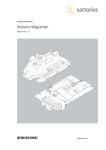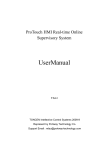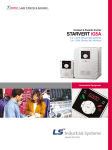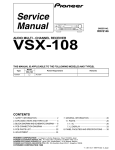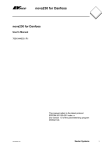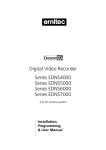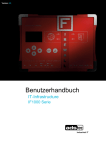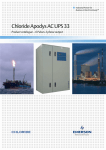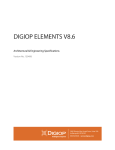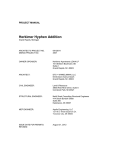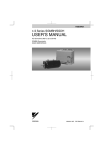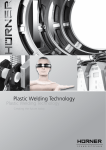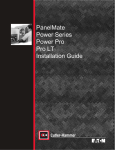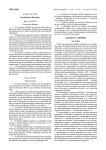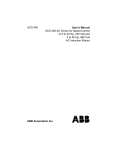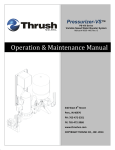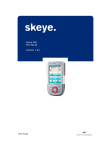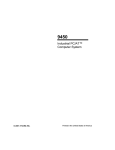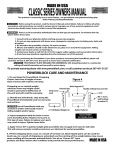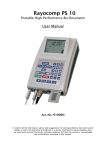Download yaskawa comparison
Transcript
A COMPETITIVE CONTRAST REPORT OF YASKAWA E7 ABB ACH400 CUTLER-HAMMER HV9000 DANFOSS VLT6000 CONFIDENTIAL Document Number: CC.E7.20 A Competitive Contrast Report of Yaskawa E7, ABB ACH400, Cutler-Hammer HV9000, Danfoss VLT6000 BLANK PAGE CONFIDENTIAL Document Number: CC.E7.20 Page 2 of 53 A Competitive Contrast Report of Yaskawa E7, ABB ACH400, Cutler-Hammer HV9000, Danfoss VLT6000 A COMPETITIVE CONTRAST REPORT OF YASKAWA E7 ABB ACH400 CUTLER-HAMMER HV9000 DANFOSS VLT6000 Prepared For Yaskawa Drives Sales Department This document compares the features and performance of the Yaskawa inverter (drive) to a competitor's inverter, considered similar. Competitor information is obtained primarily from Technical Manuals. Secondary sources include brochures, website, and performance tests. Yaskawa assumes no responsibility for the accuracy of competitor data. This comparison should be used for reference only. Prepared by: DSD Engineering Yaskawa Electric America Date: January 6, 2003 CONFIDENTIAL Document Number: CC.E7.20 Page 3 of 53 A Competitive Contrast Report of Yaskawa E7, ABB ACH400, Cutler-Hammer HV9000, Danfoss VLT6000 BLANK PAGE CONFIDENTIAL Document Number: CC.E7.20 Page 4 of 53 A Competitive Contrast Report of Yaskawa E7, ABB ACH400, Cutler-Hammer HV9000, Danfoss VLT6000 Contents I. SUMMARY 7 II. COMPETITOR BACKGROUND INFORMATION 8 A. YASKAWA B. ABB C. DANFOSS 1) DANFOSS ELECTRONIC DRIVES 2) GRAHAM D. EATON CUTLER-HAMMER 8 8 9 9 9 9 III. OBJECTIVE 10 IV. METHODOLOGY AND APPROACH 10 V. FAN AND PUMP APPLICATION PRIMER 11 VI. EVALUATION SECTION 12 A. STANDARDS B. WARNINGS AND CAUTIONS C. PHYSICAL CONSTRUCTION D. WIRING E. PARTS REMOVAL INSTALLATION F. PARTS REMOVAL INSTALLATION COMPARISON G. KEYPAD H. PROGRAMMING I. USEFUL FAN/PUMP FEATURES J. ACOUSTIC NOISE CONSIDERATIONS K. INPUT / OUTPUT INTERFACE FEATURES L. SERIAL COMMUNICATIONS M. HARMONIC, EMI/RFI AND OUTPUT DV/DT MITIGATION N. PROTECTIVE FEATURES O. TROUBLESHOOTING 12 13 14 17 18 18 27 29 30 31 32 33 34 37 38 APPENDICES 39 40 43 45 47 49 P. APPENDIX 3- KEYPAD FEATURE COMPARISON DETAILS Q. APPENDIX 4 -- PROGRAMMING COMPARISON DETAILS R. APPENDIX 5 – USEFUL FAN/PUMP FEATURE COMPARISON DETAILS S. APPENDIX 6 – TROUBLESHOOTING AND DIAGNOSTICS COMPARISON DETAIL T. APPENDIX 7 – HIGHLIGHTED DANFOSS VLT6000 VS. E7 COMPARISON CONFIDENTIAL Document Number: CC.E7.20 Page 5 of 53 A Competitive Contrast Report of Yaskawa E7, ABB ACH400, Cutler-Hammer HV9000, Danfoss VLT6000 BLANK PAGE CONFIDENTIAL Document Number: CC.E7.20 Page 6 of 53 A Competitive Contrast Report of Yaskawa E7, ABB ACH400, Cutler-Hammer HV9000, Danfoss VLT6000 I. Summary This comparison should assist Yaskawa sales in understanding the strengths and weaknesses on the E7 drive product vs. the competition. This comparison evaluates four AC drive products primarily targeted at commercial building automation/ HVAC fan and pump applications. The drive products evaluated are: • • • • Yaskawa E7 ABB ACH400 Danfoss VLT6000 Cutler-Hammer HV9000 The E7 drive is well placed to effectively compete in the targeted applications and markets. The drives are evaluated in 15 different areas ranging from physical construction to troubleshooting and maintenance. The E7 has different strengths when compared to each of the competing products. • When the E7 is compared to the ABB ACH400 the E7 is much stronger in the areas of wiring, keypad, I/O flexibility and communications. • The E7 has a significant advantage over Cutler-Hammer HV9000 in areas such as, ease of maintenance, wiring , physical construction and programming. • Finally, when the E7 is compared to the Danfoss VLT6000 the strongest competitor, physical construction and parts removal/installation are short comings of the Danfoss drive The E7 is stronger than all the competition in several areas such as: • • • Physical Construction Input/Output Interface Troubleshooting and Maintenance Figure 1. below provides a summary of the E7 vs. the competition. The chart considers all features and provides an average result for all compared areas. Figure 1. Overall Comparison Rating 100 90 80 Percentage of E7 70 60 50 E7 40 VLT6000 30 20 ACH400 HV9000 10 0 CONFIDENTIAL Document Number: CC.E7.20 Page 7 of 53 A Competitive Contrast Report of Yaskawa E7, ABB ACH400, Cutler-Hammer HV9000, Danfoss VLT6000 II. Competitor Background Information1 A. Yaskawa Since 1915 Yaskawa Electric Company has been manufacturing sophisticated electrical products. Yaskawa's sales were $2.3 billion in fiscal 2000. Yaskawa with its international operations offers Electrical system products for consumer, commercial, industrial, municipal, and utilities. The company divides its products into Industrial Electrical Control systems. Industrial Electric Components Mechatronics Systems, and Mechatronics Components products. Nearly 47 percent of it sales are from the Mechatronics Components group. This group offers motion and drive control products, including AC drives, AC/DC Servomotors motion controllers, servo systems, numeric controllers, and programmable controllers. Yaskawa pursues many alliances and partnerships to best succeed in the marketplace. Yaskawa has a 13.6% market share of low power AC drives in North America for the year 2000. Yaskawa AC Drive Business Yaskawa manufactures and assembles AC drives in facilities in Europe, Japan and the United States. Yaskawa opened a new North American headquarters in Waukegan, IL in 1999 with the goal to become the number one automation drives supplier in the US. The high volume smaller units are manufactured in Scotland and Japan. Mid-sized units are manufactured in the US, while Japan still manufactures the lower volume larger units. North America is the largest market for Yaskawa's manufactured products. Yaskawa AC Drives are aimed at a variety of industries and applications. A few examples of these applications are elevators and air conditioners in the building automation industry. Other models are used in municipal water for control pumps and transportation for monorails. Yaskawa offers are variety of products to meet the demands of the industrial marketplace. For simple applications, Yaskawa offers small generalpurpose; ultra compact variable speed drives, which are easy to operate. General-purpose drives are offered to meet the general needs of the industry. Yaskawa also offers highly functional, high-speed vector – controlled inverters. Other Yaskawa product lines are designed for energy savings, and low noise operation. B. ABB Founded in the late 1800’s, ABB, with annual revenue of about $23 billion in 2000, is one of the largest industrial companies in the world. ABB serves manufacturing, process and consumer industries, utilities, and the oil and gas markets, with 160,000 employees in more than 100 countries. World headquarters is in Zurich. ABB has a 9.0% market share of low power AC drives in North America for the year 2000. ABB AC Drive Business ABB is the largest supplier of AC drives. ABB was an early supplier of AC drives to the pulp & paper industry. Today building automation, metals & mining, and pulp & paper are ABB’s largest markets for AC drives applications such as, fans, HVAC, extrusion, material handling, metal processing, pumps and web handling. ABB offers a complete product mix from micro to mega drives. A majority of the company’s drives are furnished through direct sales and distributors. ABB generally supplies drives to end-users and some drives to OEM’s and system integrators. The drives are supplied to end-users in either stand-alone or system configurations. ABB’s installed base is varied in the industry. In the industrial market, fixed torque applications are prevalent and in the commercial HVAC market, variable torque systems are more common. 1 All Competitor Information obtained from: Low Power AC Drive North American Outlook-Market Analysis and Forecast Through 2005, ARC Advisory Group 2001. CONFIDENTIAL Document Number: CC.E7.20 Page 8 of 53 A Competitive Contrast Report of Yaskawa E7, ABB ACH400, Cutler-Hammer HV9000, Danfoss VLT6000 Competitor Background Information2 (continued) C. Danfoss Danfoss, with headquarters in Nordborg, Denmark, has annual sales of over $1.8 billion in 2000 with approximately 17,000 employees. There are sales representatives, sales offices, and service centers in 100 countries. The company is divided into three business segments: Heating & Water, Refrigeration and Air Conditioning, and Motion Controls. Danfoss has a 4.0% market share of low power AC drives in North America for the year 2000. Danfoss AC Drive Business Danfoss Drives manufactures over 100,000 drives a year with its 1,800 employees and three manufacturing facilities located in Graasten, Denmark; Rockford, Illinois; and Milwaukee, Wisconsin. In Canada and the US, there are over 100 sales and service centers. In 1995 Graham was acquired and became a division of Danfoss. 1) Danfoss Electronic Drives Danfoss Electronic Drives, a division of Danfoss A/S, markets drives for general application in industry such as HVAC, Water, Chemical, Food & beverage, Material Handling and water & waste. Danfoss manufacturers drives from the compact drive to the high end. Several midperformance inverters are available in compact sizes to high-end sizes to be used in either constant or variable torque applications. 2) Graham Graham is a division of Danfoss Inc., which specializes in marketing AC drives specifically designed for the HVAC industries. PWM units are available from micro to midrange sizes. Small vector controlled PWM drives ar part of the product line that may be applied to constant or variable torque applications. PWM’s are offered, which produce a six-step output that lowers motor stress. D. Eaton Cutler-Hammer Eaton Corporation is a global $8 billion diversified industrial manufacturer of fluid power systems; electric power quality, distribution and control; automotive engine air management and fuel economy; and intelligent truck systems for fuel economy and safety. Eaton’s 55,000 employees work in 29 countries on six continents. Eaton’s Industrial and Commercial Controls business segment manufacturers contactors, starters, drives, and other motor control products. Global markets are served by direct sales through the company or by indirect sales through distributors and manufacturer representatives. Eaton Cutler-Hammer has a 2.2% market share of low power AC drives in North America for the year 2000.. Eaton Cutler-Hammer AC Drive Business Cutler-Hammer is part of Eaton's Industrial and Controls segment. The company supplies products for power distribution equipment, electrical control, and advanced industrial automation. Included in its product offering are Cutler-Hammer's AC drives, from micros to midrange sizes. Cutler-Hammer has greatly reduced operating costs by standardizing the AC drive product line on a single model. Cutler-Hammer employs the same drive technology over the entire range. The commonality of components can have significant saving for the end user in training and spares. This multi-purpose PWM drive provides Volt/Hz, sensorless vector and closed loop flux vector modes of operation. It may be applied to constant torque or variable torque applications. The drive is preprogrammed with selectable control for various applications such as pumps, fans, mixers, ex- truders, cranes, packaging, and material handling. 2 All Competitor Information obtained from: Low Power AC Drive North American Outlook-Market Analysis and Forecast Through 2005, ARC Advisory Group 2001. CONFIDENTIAL Document Number: CC.E7.20 Page 9 of 53 A Competitive Contrast Report of Yaskawa E7, ABB ACH400, Cutler-Hammer HV9000, Danfoss VLT6000 III. Objective The evaluation is undertaken to provide a key selling tool to assist in competing with other Building Automation AC drive products. Yaskawa needed a detailed comparison of features and benefits vs. the targeted competition. The goal is to expose the weakness of the competition and to highlight the strengths of the Yaskawa E7. IV. Methodology and Approach Yaskawa Electric America performed a side-by-side comparison of three AC drive products targeted at the Building Automation and HVAC market. Comparable features are grouped into categories such as “Physical Design or Serial Communications” . The categories contain features or functions that are listed and rated under each category. A category summary is included in each section to assist the reader in understanding the importance of each category to the customer or within the HVAC market. A table containing feature descriptions is provided along with a percentage bar graph of the category rating. In addition, a textual summary contrasting the E7 and highlighting any competitive advantage of the E7. Table Description Features that can be logically compared are placed in tables. A feature or function is scored based on how it compares to the E7. Each feature evaluated rated or scored as follows: Rating Values • 0=Yaskawa Advantage, not as good as E7 • 4=Competition Advantage, better than E7 • 2= equal to Yaskawa E7 • NR = Not Rated The Rating System The rating system allow for a 0%-200% score for each category. The E7 always gets a 100% as a benchmark. This is because the E7 is the standard for which all competing products are compared. • The rating values are chosen such that if a competing product scores “4” better than E7” in all features in a category, then that product will receive a 200% overall category rating on the associated bar graph. • If a competing product scores “0 Not as good as E7” in all features in a category then that product will receive a 0% overall category rating on the associated bar graph. • Should a competing product score “2 Equal to Yaskawa E7” in all features in a category then that product will receive a 100% rating equal to the E7 on the associated bar graph. Combined Total Overall Rating An overall rating is determined by averaging all of the category score percentages to determine if the competing product is better than, equal to, or equivalent to the E7 and by what percentage. CONFIDENTIAL Document Number: CC.E7.20 Page 10 of 53 A Competitive Contrast Report of Yaskawa E7, ABB ACH400, Cutler-Hammer HV9000, Danfoss VLT6000 V. Fan and Pump Application Primer Since variable speed drives were invented some 20 years ago, energy efficiency has been one of their main selling points. VFD’s provide an opportunity to reduce energy costs by eliminating unnecessary losses in the application. In a variable volume fan application where inlet dampers or output vanes are used to control the airflow, substantial energy costs can be obtained with the application of ac drives. By controlling the speed of the fan directly, flow can be controlled and pressure losses across the fan blades can be reduced. In many applications, as much a 50% reduction in energy costs have been obtained by using ac drives to control the air flow. A classic energy efficiency application is the use of drives to control the speed of the motors that turn blowers and fans in air handing units in commercial buildings. Motor speed control alleviates the need for dampers in ductwork, and by slowing fan speed during lower demand cycles, the reduction in energy used during those periods will eventually offset the cost of the equipment. Drives are often integrated into building control, electrical and mechanical systems. Though their immediate and primary impact is a reduction in energy costs, they must operate without fail. For this reason, redundant systems such a bypass and mechanical flow control are often also installed. Other energy efficiency applications include pumps, chillers, and in some cases elevators. ASDs provide dramatic energy savings by optimizing the motor/load system--not by improving the actual efficiency of the motor in isolation, as an energy efficient motor retrofit would (Figure 1). Average loading as high as 90 percent can justify ASD retrofit for high-duty, high-utility-rate applications. In addition, the improved power factor provided by an ASD (especially pulse-width modulation (PWM) ASDs) can produce additional savings due to reduced I2R losses in the cables supplying power to the drive and motor. A survey in the United States has showed that some 40 per cent of the energy used in non-residential properties is used in HVAC applications, such as ventilation, space heating and space cooling. Using variable speed drives ensures this energy is used efficiently. CONFIDENTIAL Document Number: CC.E7.20 Page 11 of 53 A Competitive Contrast Report of Yaskawa E7, ABB ACH400, Cutler-Hammer HV9000, Danfoss VLT6000 VI. Evaluation Section This section shows evaluated features broken into groups. Each feature is rated in a table and a percentage of E7 score is shown at the bottom of each table. The percentages are also graphed for easy interpretation. In addition, A short comparison paragraph highlights the advantages of the E7 over the competition. A. Standards Standards and listings provide practical information concerning ratings, construction, test and manufacture of industrial equipment. Standards are used by the industry to provide guidelines for the manufacture and proper application of products and equipment. Standards can be application specific or very broad. It is important to understand that a manufacturer may claim adherence to a standard without specifying the “Category or Environment” within the standard. Marketing literature typically does not explain such detail. The ability of a product to comply with standards that are specified by potential users is an indication that the product is well suited to its market. Standards that are typically referenced in the Building Automation System (BAS) marketplace are chosen as a basis for this comparison. Standards/ Listings Comparison Summary Yaskawa E7 vs. the Competition 200% Better 100% Equal to E7 100% 100% 100% 100% 86% 100% ACH400 Yaskawa E7 VLT6000 Yaskawa E7 HV9000 Yaskawa E7 Worse 0% Standards Comparison The E7 is compliant with most popular standards and is on equal to the competition in the evaluated areas. Evaluation in this area is limited, as some unique standards require evaluation on a case-by-case basis. In addition, certain standards may be popular in other global markets, which are not the focus of this report. No. Standards/ Listings Comparison 1. 2. 3. 4. 5. 6. UL 508C CSA 22.2 No. 14-95 (Industrial Control Equipment)or cUL UL 1995 Plenum CE Mark Standard EN50178 of (LVD)Low Voltage Directive 73/23/EEC Standard EN61800-3 of EMC Directive 89/336/EEC amended 93/68/EEC 7. E7 VLT6000 HV9000 Yes cUL 2 2 Yes cUL 2 2 Yes cUL 2 2 Yes cUL 2 Yes 2 Yes 2 0 Not published 2 2 Yes Yes 2 2 Yes Yes 2 2 Some models require NEMA 12 Yes Yes 2 2 Requires EMC filter Yes 2 w/ external filter 2 w/ external filter 2 2 2 w/12 pulse 2 w/optional filter/reactor 2 Open chassis requires input external RFI filter. Integral 3% AC three phase reactor supplied.> 2HP Optional separate 12 pulse bridge >100HP 14 = 100% IEEE 519: Harmonic Control in Electrical Power Systems TOTAL SECTION SCORE ACH400 2 2 100% of E7 Built-in DC link w/optional filter/reactor 2 100% of E7 86% of E7 Legend: (0=Yaskawa Advantage), (4=Competition Advantage), (2= equal to Yaskawa), (NR = Not Rated) CONFIDENTIAL Document Number: CC.E7.20 Page 12 of 53 A Competitive Contrast Report of Yaskawa E7, ABB ACH400, Cutler-Hammer HV9000, Danfoss VLT6000 B. Warnings and Cautions A properly labeled product and documentation can help prevent damage to equipment and danger to personnel. However, warnings and cautions that are unique and/or excessive may be an indication that the product design is not well suited to its application. Manufacturers should attempt to fully document product warnings and cautions. The product should be of robust designed to minimize unique warnings or cautions. This comparison rates how well warnings and cautions are documented and penalizes products for unique cautions that may limit user or application flexibility. Warnings/ Cautions Feature/Function Comparison Summary Yaskawa E7 vs. the Competition 200% Better 100% Equal to E7 Worse 0% ACH400 No. 100% 75% 100% 100% 100% 50% Yaskawa E7 VLT6000 Warnings/Cautions 1. Number of warnings or dangers. 2. Number of cautions. 3. Number of warnings or cautions not Yaskawa E7 HV9000 Yaskawa E7 ACH400 E7 VLT6000 HV9000 2 18 2 18 4 36 0 10 2 30 0 20 0 29 0 13 2 30 4 11 4 10 4 1 2 0 0 3 0 11 0 5 labeled or improperly labeled as warnings or cautions. 4. Number of unique warnings/cautions that may limit user flexibility. 8 = 100% 75% of E7 100% of E7 50% of E7 TOTAL SECTION SCORE Legend: (0=Yaskawa Advantage), (4=Competition Advantage), (2= equal to Yaskawa), (NR = Not Rated) Note: These definitions are used to determine a “Warning or a Caution” Warning-Danger or injury to personnel Caution: May cause damage to equipment. Note for 1. or 2.--All notes or text that fit the warning or caution definition above are counted as warning or a caution even if it is not labeled as such. Note for 2. – Warning or cautions mabe be counted multiple times. If a warning or caution is considered as “a unique a unique warning or caution” in No. 3 above., it is also considered in the total number of warnings or caution in No. 1 or 2 above. CONFIDENTIAL Document Number: CC.E7.20 Page 13 of 53 A Competitive Contrast Report of Yaskawa E7, ABB ACH400, Cutler-Hammer HV9000, Danfoss VLT6000 C. Physical Construction Good physical design can be measured by several important factors. Compact design can help save valuable enclosure or floor space. Installation and repair time can be minimized by well-designed enclosure features. A variety of available enclosure types can help ensure the drive can tolerate its environment. Conveniently placed exterior labels, markings and other indicators can reduce time and effort required to identify the drive or troubleshoot systems faults. This comparison focuses on rating the products exterior design physical construction features. Electrical component construction is beyond the scope of this comparison. Physical Construction Comparison Summary Yaskawa E7 vs. the Competition 200% Better 100% Equal to E7 100% Worse 0% 100% 50% 100% 43% ACH400 Yaskawa E7 36% VLT6000 Yaskawa E7 Product Weight Comparison HV9000 Output Ampacity Comparison The E7 product weighs 50% less than the Danfoss VLT6000. The E7 also compares favorably to the HV9000 and the ACH400 in this area. Yaskawa fits great performance in a light package. This results in lower shipping costs and comparatively easier installation. The E7 product line provides more output amps overall than the competition. The E7 provides higher motor performance by delivering more amps to the load . A detailed chart indicates the E7 is especially powerful in the 230 volt class. Combined Product Line Weight of Twenty Six Comparable Models (ranging 3-100 HP) Accumulative Weight in Pounds Combined Product Line Output Amperage Capacity of Twenty Six Comparable Models (ranging 3-100 HP) Accumulative Drive Output Amps More Amps for More Motor Performance 2400 Higher Shipping Costs $ Yaskawa E7 2200 2000 1400.0 1380.0 1800 1600 1360.0 1400 1200 1340.0 1000 $ Lower Shipping Costs 800 1320.0 600 400 Less Amps is less Performance 200 0 1280.0 E7 ACH400 VLT6000 HV9000 E7 Drive Output Amps vs. Horsepower Comparison 230V Models 162 162 Drive Nameplate Amps 160 E7 230V Models 140 115 120 100 VLT6000 Output Ampacity 88 74.8 80 59.4 ACH400 Output Ampacity 46.2 31 40 16.8 10.8 20 ACH400 VLT6000 Drive Output Amps vs. Horsepower Comparison 460V Models 23 140 Drive Nameplate Amps 180 60 1300.0 125 0 5 10 15 20 25 30 35 Drive Horsepower CONFIDENTIAL 40 45 50 55 60 HV9000 Output Ampacity E7 Output Ampacity 120 96 100 77 80 67.2 67.2 VLT6000 Output Ampacity 60 40 ACH400 Output Ampacity 34 40 27 27 17 12.5 7.6 20 0 0 HV9000 0 5 10 15 20 25 30 35 40 45 50 55 60 65 70 75 80 85 90 95 10 10 0 5 Drive Horsepower Document Number: CC.E7.20 HV9000 Output Ampacity Page 14 of 53 A Competitive Contrast Report of Yaskawa E7, ABB ACH400, Cutler-Hammer HV9000, Danfoss VLT6000 Physical Construction Comparison (continued) Combined Product Line Volume Requirement of 26 Comparable Models (ranging 3-100 HP) Accumulative Cubic Inches 90000.0 More Mounting or Floor Space Required 80000.0 70000.0 60000.0 Volume Requirement 50000.0 40000.0 30000.0 20000.0 Less Mounting or Floor Space Required 10000.0 0.0 E7 More Mounting or Floor Space Required ACH400 VLT6000 HV9000 Drive Volume by Model of 26 Comparable Models (ranging 3-100 HP) Drive Volume Cubic Inches 7000.0 6000.0 230V Models 5000.0 460V Models Yaskawa E7 4000.0 3000.0 ABB ACH400 2000.0 Less Mounting or Floor Space Required 1000.0 0.0 3 7.5 15 25 More Mounting or Floor Space Required 40 60 7.5 15 25 Drive Horsepower 230V Models 40 60 100 460V Models The E7 beats the competition by providing the most compact drive size. Minimizing the space required by the drive reduces enclosure space cost as well as the cost for providing floor and wall space. The most significant volume savings is obtained when the E7 is compared against the Danfoss VLT6000. The E7 drive line up requires 50% less volume than the Danfoss drive. A model by model comparison shows that the Cutler Hammer HV9000 and the ABB ACH400 are at least 25% larger overall than the E7. Drive Volume by Model of 26 Comparable Models (ranging 3-100 HP) Drive Volume Cubic Inches 8000.0 7000.0 230V Models 6000.0 Yaskawa E7 460V Models 5000.0 CutlerHammer HV9000 4000.0 3000.0 2000.0 Less Mounting or Floor Space Required 1000.0 0.0 3 7.5 15 25 230V Models More Mounting or Floor Space Required 40 60 7.5 15 Drive Horsepower 25 40 60 100 460V Models Drive Volume by Model of 26 Comparable Models (ranging 3-100 HP) Drive Volume Cubic Inches 8000.0 7000.0 230V Models 6000.0 5000.0 460V Models Yaskawa E7 Danfoss VLT6000 4000.0 3000.0 2000.0 Less Mounting or Floor Space Required 1000.0 0.0 3 7.5 15 25 230V Models CONFIDENTIAL 40 60 7.5 15 Drive Horsepower 25 40 60 100 460V Models Document Number: CC.E7.20 Page 15 of 53 A Competitive Contrast Report of Yaskawa E7, ABB ACH400, Cutler-Hammer HV9000, Danfoss VLT6000 Physical Construction Comparison (continued) No. Physical Construction Comparison 1. Total size by volume (cu. in) occupied by 26 different drives in 3-100HP lineup. NEMA 1 stand alone. 2. Total combined weight of 26 different drives in 3-100HP line-up. (lbs) 3. 6. Listing/certification labels on enclosure NEMA 1 convertible to chassis style. 7. 53771.25891 0 81776.59277 0 56188.7183 2 934.4 0 1167.6 0 2226 0 1653.5 2 Model: , Spec: , Input: V-Hz-A, Output: V-Hz-A, Order#: , Serial#: , Mass: , ULfile#: , Encl type: , 0 Nameplate does not spell out Input/Output Example: U1-U2-I1nI1nhd-I2n-I2nhd-f1-f2 are used-this is difficult to read. (Mass, UL file# and Enclosure Type not listed.) 0 Mass not listed , UL file# is on separate label 0 Mass not listed, UL file # not listed 2 Risk of Shock warning in two languages-front cover, Pass inspection stamp on heatsink. 2 Shock warning graphic 2 Service label with phone # , Shock Risk on bottom 0 Risk of Shock label on side of unit not visible from front. 2 cUL, UL, CE 2 2 cUL, UL, CE 2 cUL, UL, CE 2 Yes 0 cUL, UL, CE on nameplate No 2 Yes 0 No 2 Cover, sides, Fan No tools required 0 Cover , sides, fan w/tools 0 Yes, Top bottom, sides, fan w/tools 0 2 DigOP, FrontCover, Sides, fan bracket #2 Phillips or flat 2 DigOP, FrontCover, Sides Flat screwdriver 0 DigOp 0 Sheet Metal is U formed sides cannot be easily replaced, fan w/tools DigOp 2 Flat screwdriver 2 Flat screwdriver 0 NEMA 1/IP21 wall mount to 150HP 480V and to 100HP 240V, 0 NEMA 1/IP21 wall mount to 300HP 480V and to 60HP 240V, 0 NEMA 1/IP21 wall mount to 400HP 480V and to 100HP 240V, 2 NEMA1/IP21 wall mount to 500 HP 480V and to 150HP 240V, Optional 4 NEMA 12/IP54 wall mount to 60HP 230V and to 100HP 480V, 4 NEMA 12/IP54 wall mount to 300HP 480V and to 60HP 240V, 4 NEMA 12/IP54 wall mount to 400HP 480V and to 100HP 240V, 2 All 2 Yes 0 No 2 2 No-(Endcaps only) 0 NEMA 1/IP21 floor mount required 150400HP- 480V and n/a 240V, NEMA 12/IP54 floor mount required 75-100HP 230V and 125-400HP480V, 0 NEMA 1/IP21 floor mount required 350600HP- 480V, n/a 240V, NEMA 12/IP54 floor mount required 350-600HP480V, n/a 240V, 0 Open Chassis IP00 to 150HP 230V and to 1000HP 480V Floor Mount is optional kit 2 Removable fan-no tools lower HP models, Plower Half cover removal protects control PCB when wiring. 0 Replaceable exterior components. 8. Exterior components labeled w/ part number. 9. Tools required to remove front cover. 2 2 10. Standard NEMA 1 Range 11. 2 Standard NEMA 12 Range 12. HV9000 0 Other Markings/Labels. 5. VLT6000 39847.63029 Namplate Labeling. 4. ACH400 E7 2 Open Chassis Available 13. Floor Mount Required 15. Unique Enclosure Features TOTAL SECTION SCORE 28 =100% 50% of E7 0 0 43% of E7 36% of E7 Legend: (0=Yaskawa Advantage), (4=Competition Advantage), (2= equal to Yaskawa), (NR = Not Rated) CONFIDENTIAL Document Number: CC.E7.20 Page 16 of 53 A Competitive Contrast Report of Yaskawa E7, ABB ACH400, Cutler-Hammer HV9000, Danfoss VLT6000 D. Wiring A drive that is easily wired can reduce both ownership and installation costs. Simple wiring and piping connections and components that can be replaced without rewiring results in a product that is economical to install and maintain. Cost savings can be further increased by a product that does not require expensive or highly skilled personnel to maintain or service. This comparison evaluates features related to the wiring installation of the drive. Wiring/ Installation Comparison Summary Yaskawa E7 vs. the Competition 200% Better 100% Equal to E7 122% 100% 100% 100% 44% Worse 0% ACH400 44% Yaskawa E7 VLT6000 Yaskawa E7 HV9000 Yaskawa E7 Wiring Comparison The competition was evaluated side-by-side with the E7. The sample drives used were 460V 5HP. The drives were mounted and wired to both control and power circuitry. The E7 is much easier to wire than Cutler-Hammer and ABB. The Cutler-Hammer HV9000 was especially difficult to connect. (see detailed photos). The ACH400 from ABB exhibited challenges in the control wiring. The Danfoss VLT6000 and E7 were equally convenient to wire and install. (see detailed photos and comments in the following pages). The E7 provides simple, easy wiring and installation when compared to the competition. Wiring/ Installation features of the ABB and Cutler-Hammer drives rate poorly in comparison. No. 1. 2. 3. Wiring/Installation Comparison Detachable conduit entry plate. Detachable control terminal blocks. Power Terminal labeling. 4. E7 ACH400 PCB component exposure during wiring. 6. 2 2 Yes No 2 4 Knockouts Yes PowerBlocks also 0 2 No Yes 2 Clearly Labeled 0 2 Clearly Labeled 2 Clearly Labeled 2 Clear on cover 0 Bottom of block , not easily seen Silk screened on PCB but gets blocked when wired. 2 Clear on removable cover 0 2 Protected 2 Protected 2 Protected 0 Not clear terminals can be mixed up and improperly plugged easily. 60% exposed 2 TB is removable, plenty of dressing room 0 Difficult to close cover w/o pinching cable 2 TB is removable, plenty of dressing room. Block is at 45 degree angle to user+ 0 Control wires are at 90 degrees to front metal cover with only 3/8 inch bending radius. 2 2 2 No I/O 3.5 mm spacing Minimum bending required. Bottom centry always good w/ removable conduit entry. 0 2 0 Yes I/O 3.5 mm spacing I/O clearance is not good w/ < 1 inch to side cover and 90 degree bend required. 2 2 4 No I/O 3.5 mm spacing Ample wiring room. Comfortable to wire. 2 2 0 No I/O 3.5 mm spacing Both control and power wiring have tight clearances and bending radius. Ease of I/O access 7. 8. 9. Keypad removal required to wire? Terminal size and orientation. Wiring clearances TOTAL SECTION SCORE HV9000 Yes Yes Control terminal labeling. 5. VLT6000 2 2 18 = 100% 44% of E7 122% of E7 44% of E7 Legend: (0=Yaskawa Advantage), (4=Competition Advantage), (2= equal to Yaskawa), (NR = Not Rated) CONFIDENTIAL Document Number: CC.E7.20 Page 17 of 53 A Competitive Contrast Report of Yaskawa E7, ABB ACH400, Cutler-Hammer HV9000, Danfoss VLT6000 E. Parts Removal Installation As equipment ages, routine maintenance and parts replacement may be required. Parts replacement and the availability of service procedures should be easy to keep maintenance costs to a minimum. A spares program is often in place with HVAC systems, parts commonality between drive product will help keep the required inventory to a minimum. The comparison rates the competition against the E7 in parts removal and installation as well as access to parts and information. Parts Removal Installation Comparison Summary Yaskawa E7 vs. the Competition 200% Better 100% Equal to E7 100% Worse 0% 100% 0% 100% 0% ACH400 Yaskawa E7 0% VLT6000 Yaskawa E7 HV9000 Yaskawa E7 F. Parts Removal Installation Comparison The E7 is the easiest drive to replace the main PCB. The ACH400 and VLT6000 presented a greater challenge to replace the main PCB. The Cutler-Hammer HV9000 has the most difficult PCB replacement with difficult to remove cable harnesses and tight finger clearances. (see detailed photo’s on following pages). No. Parts Removal Installation Comparison E7 3. I/O logic/control PCB replacement 2 Excellent-complete primary spare parts list in user manual Excellent- Cassette removable fan w/o tools on smaller models. Very simple-see detail TOTAL SECTION SCORE 6 = 100% 1. Spares recommendations/ Determining 2 the part number 2 2. Fan replacement ACH400 0 VLT6000 HV9000 0 No spares listed in manual 0 0 No spares listed in manual only optional components Tools required 0 Enlosure disassembly required 0 0 Difficult- see detail 0 Difficult-see detail 0 0% of E7 0% of E7 No spares listed in manual only optional components Sheetmetal removal/ enclosure disassembly required Extremely difficult see detail 0% of E7 Legend: (0=Yaskawa Advantage), (4=Competition Advantage), (2= equal to Yaskawa), (NR = Not Rated) CONFIDENTIAL Document Number: CC.E7.20 Page 18 of 53 CONFIDENTIAL Document Number: CC.E7.20 Page 19 of 53 E7 Wiring – Comments: Wiring the E7 is easy and straightforward. Only two standard tools are required for wiring connections on this model. The unique split cover protects the control board and keeps the digital operator in place during wire termination. The easily removed pre-punched bottom conduit plate allows free hand movement. The I/O block is removed by loosening two captive screws and is easy to wire while holding in the hand. There were no unusual techniques or tools required in making wire terminations. A Competitive Contrast Report of Yaskawa E7, ABB ACH400, Cutler-Hammer HV9000, Danfoss VLT6000 CONFIDENTIAL Document Number: CC.E7.20 2. Remove left and right phillips screws Page 20 of 53 3. Remove option PCB support 4. Pull back plastic spring retainer and slide out PCB. 1. Remove header plug E7 PCB Replacement – Comments: E7 main PCB replacement is performed with a single Phillips screw driver and without removing wire terminations. The top cover can be removed with one hand. Loosen and disconnect the pluggable I/O block, two retaining screws, a single header plug and pop out the board. Installation is the opposite and is just as simple. Notice that no high voltage connections or bus bars are dangerously exposed during removal. A Competitive Contrast Report of Yaskawa E7, ABB ACH400, Cutler-Hammer HV9000, Danfoss VLT6000 CONFIDENTIAL Document Number: CC.E7.20 Page 21 of 53 ABB ACH400 Wiring – Comments: Wiring the ABB ACH400 is more difficult than the E7. The front cover and keypad must be removed. Power wiring seemed straightforward, however it would be very difficult to route 27 control wires in the narrow path provided. A single 4-conductor shielded cable seemed to fill the channel. In addition, control wiring terminations are at a right angle to the entry point providing little bending radius and potentially stressing the wires. Wires are easily pinched and require careful dressing when replacing the front cover. Wiring terminations required three tools and took longer than the E7 due to control wiring complications. A Competitive Contrast Report of Yaskawa E7, ABB ACH400, Cutler-Hammer HV9000, Danfoss VLT6000 CONFIDENTIAL Document Number: CC.E7.20 Page 22 of 53 ABB ACH400 PCB Replacement – Comments: Replacing the ACH400 PCB is more difficult and time consuming, and requires more steps than the E7. The process required removal of all control wiring points, which may lead to wiring errors on reinstallation. Some guesswork is involved in understanding cover removal. Ultimately two tabs must be pried apart simultaneously before the cover can be removed. The PCB is held captive inside the front cover, which then hangs stressing two ribbon cables. It is easy to be intimidated by exposed high voltage circuitry when reaching to remove the ribbon cables. Two plastic retainers must be pried aside simultaneously to free the PCB. Three separate tools are required as well as rewiring of the control terminals. A Competitive Contrast Report of Yaskawa E7, ABB ACH400, Cutler-Hammer HV9000, Danfoss VLT6000 CONFIDENTIAL Document Number: CC.E7.20 Page 23 of 53 Danfoss VLT6000 Wiring – Comments: Wiring the VLT6000 did not pose any significant challenges. The plastic bottom conduit plate seems flimsy unless a metal plate is provided. The drive requires three tools to wire instead of two for the E7. One large flat screwdriver is used to remove the metal conduit knockout for the control wiring. The control wiring knockouts become a loose part and may get lost in the drive unless immediately discarded. The pluggable power connectors have the clamping point ¼ inch deep inside the connector. This makes it difficult to inspect for pinched wire insulation and proper electrical connection. In addition, the VLT6000 requires more effort to wall mount because it is the heaviest of the drives compared A Competitive Contrast Report of Yaskawa E7, ABB ACH400, Cutler-Hammer HV9000, Danfoss VLT6000 CONFIDENTIAL Flat cable communication option connectors. ~3mm wide. Very small and fragile to connect. Document Number: CC.E7.20 Page 24 of 53 Torx driver Danfoss VLT6000 PCB Replacement – Comments: Replacing the control PCB on the VLT6000 was more difficult than the E7, with lack of instructions and special tools required. The VLT6000 manual does not describe PCB removal. A separate serial communications manual explained removal as a part of option PCB mounting. However, communication manuals are not shipped unless the options are installed. PCB replacement required a T9 Torx driver and two other screwdrivers (a total of three tools). The Torx driver is a specialty tool. PCB removal required loosening five screws and two ribbon connectors. In addition, if the gate drive PCB is replaced , chassis sheet metal will need to be removed. A Competitive Contrast Report of Yaskawa E7, ABB ACH400, Cutler-Hammer HV9000, Danfoss VLT6000 CONFIDENTIAL Non-removable conduit plate makes for tight fit. Page 25 of 53 Pluggable connectors are not keyed and are easily plugged into the wrong position. The HV9000 is the only drive where bottom access is required to remove the cover. Document Number: CC.E7.20 Sharp bending radius with wires at 90 degrees to cover. Only 3/8 inch spacing to front cover when installed. Tallest drive with least bottom wiring clearance. Non-removable conduit plate makes for tight fit. 2.75 inches Cutler-Hammer HV9000 Wiring – Comments: Wiring the VLT6000 was the most challenging of all the drives. The HV9000 had tight clearances, sharp wire bending radius and four tools required. The control terminals are without keys can be easily plugged into the wrong position with four identical blocks. As short stubby screwdriver added to the tool set as removing the cover required access to the bottom of the drive. The HV9000 would be considered difficult to wire inside an enclosure when compared to the easy access of the E7. A Competitive Contrast Report of Yaskawa E7, ABB ACH400, Cutler-Hammer HV9000, Danfoss VLT6000 CONFIDENTIAL Four tight and short cable connections make removal/installation difficult. four each side access screws could be a Document Number: CC.E7.20 The most loose hardware of all drives compared. No keys/ multiple blocks can be plugged to any position. Page 26 of 53 Cutler-Hammer HV9000 Replacing PCB – Comments: This was the most difficult PCB to replace of all the drives compared. Side access screws and exposed power circuitry are concerns. The most difficulty occurred in removal of four very short cable connectors attached to the board. Finger clearance was not adequate to grasp the headers; the cables/wires were grasped to remove the plugs. Installation was more difficult as cables come unplugged while seating others. It is also very easy to improperly connect the main four position I/O plugs into the wrong place on the block. Terminal block numbers needed close attention for correct termination. Seven pieces of loose hardware and three tools combined with difficult cable connections made the HV9000 PCB the most difficult to replace. A Competitive Contrast Report of Yaskawa E7, ABB ACH400, Cutler-Hammer HV9000, Danfoss VLT6000 A Competitive Contrast Report of Yaskawa E7, ABB ACH400, Cutler-Hammer HV9000, Danfoss VLT6000 G. Keypad The keypad or digital operator is the drive component the user must become familiar with to configure, operate, adjust and diagnose the drive. The keypad/digital operator design can simplify or complicate many aspects of user interaction with the drive. Users often form opinions on the product based on how easy it is to operate, configure, monitor status or troubleshoot the drive. In addition, digital operator design can increase or decrease cost of installation or ownership. For example: drive start-up or diagnostic time can be minimized with a easily understood interface that readily conveys information to the user. User exposure to the keypad / digital operator is often limited to equipment set-up or troubleshooting. Good interface design is critical because users often go for long periods without using the keypad. Ideally, the keypad should be able to easily convey information and allow drive configuration without the use of reference documents that may not be readily available. This comparison rates keypad/digital operator ergonomics, configuration and diagnostics capabilities. Some scores are subjective because opinions on desirable features may vary between individuals. Keypad Feature Comparison Summary The digital operators were evaluated in 37 different areas or categories. The physical characteristics and functionality of the E7 keypad are well designed. The ABB ACH400 and Cutler-Hammer keypads received the lowest rating when compared to the E7. The Danfoss VLT6000 exhibited some weaknesses in physical design but compensated for this in keypad functionality and ended up with a slightly higher rating than the E7. Overall, the E7 keypad is well placed against the competition. A detailed explanation of Keypad Feature comparisons is located in Appendix 3- Keypad Feature Comparison Details. Keypad Feature/Function Comparison Summary Yaskaw a E7 vs. the Competition 200% Better 100% Equal to E7 100% Worse 0% 115% 100% 100% 62% ACH400 CONFIDENTIAL 56% Yaskawa E7 VLT6000 Yaskawa E7 HV9000 Document Number: CC.E7.20 Yaskawa E7 Page 27 of 53 A Competitive Contrast Report of Yaskawa E7, ABB ACH400, Cutler-Hammer HV9000, Danfoss VLT6000 Keypad Photos CONFIDENTIAL Document Number: CC.E7.20 Page 28 of 53 A Competitive Contrast Report of Yaskawa E7, ABB ACH400, Cutler-Hammer HV9000, Danfoss VLT6000 H. Programming An intuitive parameter structure within the drive is critical when dealing with a potentially hundreds of settings. AC drives can posses hundreds of settings. This complexity is a result of the need for drives to be flexible in their application. Typically only 10-20% of drive parameters are used for a majority of applications. How well the parameter structure is configured can influence the usability of the product. Manufacturers typically group less common parameters separately from more commonly used parameters to allow easy navigation and start-up when the drive is first used. How quickly a more common parameter such as (acceleration time) is accessed and adjusted can be an indication of programming ease. The same can be said for how easily a less common parameter is accessed. Some manufacturers provide computer software or other tools to simplify programming. This comparison rates the drives ease of programming for the first time user. It is understood that an interface may become easier to use as one becomes more familiar with it. Programming Comparison Summary Yaskawa E7 vs. the Competition 200% Better 100% Equal to E7 100% 65% Worse 0% ACH400 82% 100% 100% 35% Yaskawa E7 VLT6000 Yaskawa E7 HV9000 Yaskawa E7 Programming Comparison Programming of the drive was evaluated using 17 different areas. The E7 had more parameters and more PID adjustments than the competition. In addition, the standard CAT5 cable for keypad connection is available at any Radio Shack. A strong point for the E7 is that the drive can be test run right out of the box by just pressing the HAND key. Programming comparison details can be found in Appendix 4 -- Programming Comparison Details. CONFIDENTIAL Document Number: CC.E7.20 Page 29 of 53 A Competitive Contrast Report of Yaskawa E7, ABB ACH400, Cutler-Hammer HV9000, Danfoss VLT6000 I. Useful Fan/Pump Features The drives in this comparison are designed to meet the needs of the Building Automation System marketplace. A large set of features specific to fan and pump applications is characteristic of a flexible product that is well suited to its market. A large functionality set may also be an indication of the manufacturers industry experience and will help integrate and tailor the drive to its application. These features are mainly designed into the drives software as parameter functions. The drives input/output interface is also considered. This comparison rates the presence of desirable HVAC and pump performance features. Useful Fan/Pump Feature Comparison Summary Yaskawa E7 vs. the Competition 200% Better 100% Equal to E7 100% Worse 0% 68% ACH400 Yaskawa E7 80% VLT6000 100% 100% 64% Yaskawa E7 HV9000 Yaskawa E7 Useful Fan/Pump Feature Comparison Useful features of the drives are compared in 25 different areas. Overall, the E7 is the strongest in providing a well rounded useful feature set for fan and pump applications. E7 vs. ABB ACH400 The ABB drive lacks, motor pre-heat, V/f pattern flexibility and user restorable parameter sets. In addition, Bi-directional speed search and energy saving features are missing from the ABB drive. Automatic energy savings should be standard in a drive targeted for the HVAC market. E7 vs. Danfoss VLT6000 The E7 has twice as many PID set-up parameters to fine tune PID applications. In addition, the VLT6000 lacks preset V/f patterns and S-Curve accel/decel curves. E7 vs. Cutler-Hammer HV9000 The HV9000 lacks motor auto-tuning and has limited V/f pattern flexibility. In addition, no run permissive input, bi-directional speed search or automatic energy savings can be found in the HV9000. Details on Useful Fan/Pump Features can be found in Appendix 5 -- Useful Fan/Pump Feature Details CONFIDENTIAL Document Number: CC.E7.20 Page 30 of 53 A Competitive Contrast Report of Yaskawa E7, ABB ACH400, Cutler-Hammer HV9000, Danfoss VLT6000 J. Acoustic Noise Considerations Acoustic noise is an concern in building automation systems. HVAC installations will often be evaluated for noise against Room Criterion Curves (RC). Room Criterion Curves specify acceptable ambient noise levels for many public buildings. Sound and vibration levels of the drive system are influenced by the following parameters: --Electromagnetic design of the motor --Control type --Resonance of the motor’s frame structure and enclosure --Integrity, mass, and configuration of the motor’s base mounting structure --Sound and vibration originating at the coupling between the motor’s shaft and the driven load --Windage Selecting a quiet drive and motor type can help to reduce the overall ambient Sound Pressure Level of an HVAC system. This comparison rates drive features that can help mitigate motor electrical noise. Acoustic Noise Comparison Summary Yaskawa E7 vs. the Competition 200% Better 100% Equal to E7 100% Worse 0% 100% 50% 0% ACH400 100% Yaskawa E7 50% VLT6000 Yaskawa E7 HV9000 Yaskawa E7 • Acoustic Noise Comparison The E7 posseses a higher carrier frequency and special software functionality to help with motor noise in fan/pump applications. The competition typically has lower carrier frequencies on average and requires derating to obtain a carrier greater than 8-10 kHz on most models. The E7 has both a higher carrier and special PWM modulation software to help limit motor noise. (see the table below) No. Acoustic Noise Comparison E7 2 1. Special motor noise reduction software/parameter function. 2 2. Switching Frequency above 10kHz TOTAL SECTION SCORE 4 Yes -PWM control by moving the peak of the noise to a frequency band in which the human's audibility is poor. All 230V models : except 50/60HP & 460V models <10HP & 20-30HP no derating =100% ACH400 VLT6000 HV9000 0 Only by increasing carrier frequency to 8khz or asynchronous 2 Automatic Switching frequency modulation, increases carrier only when load is below 60%. 0 Only by increasing carrier frequency 0 8 kHz or Asychronous w/derating 0 All models defaulted to 4.5kHz and must be derated above 4.5Khz 2 3.6kHz>40HP otherwise 10kHz all other models.all models settable to at least 10khz with only 6 models requiring no derating. 0% of E7 50% of E7 50% of E7 Legend: (0=Yaskawa Advantage), (4=Competition Advantage), (2= equal to Yaskawa), (NR = Not Rated) CONFIDENTIAL Document Number: CC.E7.20 Page 31 of 53 A Competitive Contrast Report of Yaskawa E7, ABB ACH400, Cutler-Hammer HV9000, Danfoss VLT6000 K. Input / Output Interface Features The drive must interface with either a building management system or a PLC controller. Operation of the drive is usually turned over to a remote system during commissioning. The quantity and flexibility of digital and analog input/output points can allow the drive to perform functions normally performed by costly add-on devices. A flexible I/O often allows the system to be used for more than just motor speed control. For example: A time delay relay built into the drive may be used to delay drive start without adding a separate relay to perform this same function. This comparison rates the quantity of I/O points as well as the number of programmable functions. I/O Comparison Summary Yaskawa E7 vs. the Competition 200% Better 100% Equal to E7 100% 100% 46% Worse 0% ACH400 100% 69% Yaskawa E7 38% VLT6000 Yaskawa E7 HV9000 Yaskawa E7 Input / Output Interface Comparison The E7 compares very favorably to the competition in both the quantity of I/O points as well as the flexibility of the I/O to be programmed to the applications needs. No. ***Standard I/O Comparison 1. E7 3. Voltage Analog Input Converts to mA input Analog Output Qty AO selectable , Voltage or Current 4. 5. 6. 7. 8. 9. 10. 11. Digital Input Qty Digital Input Sinking/Sourcing Digital Input External Supply Allowed Digital Output Relay Qty Open-collector Qty Number of programmable functions AI Number of programmable functions AO Number of programmable functions DI 12. Number of programmable functions DO. TOTAL SECTION SCORE VLT6000 2 each/ 1 is programmable 4 2 each/ 2 are programmable 4 2 Yes 2 Yes 0 2 2 each/ 2 are programmable Yes 7 each/ 5 are programmable Yes Yes 0 1 each/ 1 is programmable No- mA only 5 each/ 5 programmable NPN only No 2 3 each/ 2 are programmable 0 2 each / 2 are programmable 0 Analog Input Qty 2. ACH400 2 2 2 2 2 2 0 0 0 0 0 2 0 4 2 each/ 2 are programmable 0 No 2 each/ 2 are programmable No 8 each/ 8 are programmable No Yes 0 1 each/ 1 is programmable No 6 each/ 6 are programmable Yes No 2 each/ 2 are programmable 0 0 0 2 0 2 2 7 different functions 2 0 3 different functions 2 0 4 different functions 4 0 2 18 different functions 0 17 different functions 0 *5 different functions 0 2 59 different functions 0 11 different functions 0 25 different functions 0 2 27 different functions 4 32 different functions 4 *29 different functions 0 26 0 0 4 HV9000 3 each, (2voltage, 1current) / 3 are programmable No 46% 69% 0 2 each/ 2 are programmable 1 each **5 different functions **16 different functions **12 different functions **26 different functions 38% Legend: (0=Yaskawa Advantage), (4=Competition Advantage), (2= equal to Yaskawa), (NR = Not Rated) *Note: The VLT6000 analog outputs also function as digital DC outputs. ** Note: The VLT6000 "Pump and fan control Application" was used to determing programmable functions, this application seemed to have the most functions of all the HV9000 applications. ***Note : Expandable I/O is not considered in this evaluation CONFIDENTIAL Document Number: CC.E7.20 Page 32 of 53 A Competitive Contrast Report of Yaskawa E7, ABB ACH400, Cutler-Hammer HV9000, Danfoss VLT6000 L. Serial Communications With the increasing need for control and integration of automation devices in facility information systems, the flexibility and ease of communication capabilities in adjustable speed drives is vital. A number of factors should be considered when looking at communications, for example; • The drive may need to be controlled by programmable controllers or by a building management system. • The drive's communications capabilities should be flexible enough to meet present and future needs. • Communications links should be easily accessible and simple to install. This comparison rates the number of supported protocols and if these are built-in or standard with the drive. Serial Communications Comparison Summary Yaskawa E7 vs. the Competition 200% Better 100% Equal to E7 100% Worse 0% 100% 80% 100% 40% ACH400 40% Yaskawa E7 VLT6000 Yaskawa E7 HV9000 Yaskawa E7 Serial Communication Comparison The E7 is significantly stronger than ABB or Cutler-Hammer in the serial communications comparison. Builtin protocols such as Landis and Johnson Controls give the E7 a competitive edge. The Danfoss VLT6000 chooses to support their own proprietary protocol instead of Modbus as standard. The VLT6000 also does not have a built-in RS-232 connection like the E7. No. Serial Communications Comparison 1. 2. 3. 4. Built-in RS-232 Built-in RS-485 Built-in Modbus 5. Built-in Seimens/Landis APOGEE FLN 6. Built-in Johnson Controls Metasys N2 Built-in Other TOTAL SECTION SCORE E7 ACH400 VLT6000 HV9000 2 2 2 2 Yes Yes Yes Yes 0 2 2 0 No Yes Yes No 0 2 0 2 No Yes No Yes 2 0 0 0 RS-232 No No No 2 Yes 0 No 2 Yes 0 No 0 No 0 No 2 Yes (Danfoss protocol) 2 Yes 10 = 100% 40% of E7 80% of E7 40% of E7 Legend: (0=Yaskawa Advantage), (4=Competition Advantage), (2= equal to Yaskawa), (NR = Not Rated) CONFIDENTIAL Document Number: CC.E7.20 Page 33 of 53 A Competitive Contrast Report of Yaskawa E7, ABB ACH400, Cutler-Hammer HV9000, Danfoss VLT6000 M. Harmonic, EMI/RFI and Output dV/dT Mitigation Providing cost effective power quality solutions are important in a drive product. To minimize harmonics problems, an increasing number of ASD manufacturers are packaging harmonicsmitigating equipment (such as line reactors or isolation transformers) with drives. These features can allow users to enjoy the full benefits of power factor improvement. In addition, this added equipment can significantly reduce the impact of ASD-generated harmonics on other electronic equipment--a benefit that should be especially attractive to value-conscious commercial and industrial users. This comparison rates the competition against the E7 in providing power quality solutions. A Primer on Power Quality solutions for AC Drives How are power line harmonics created with an AC drive? Since the DC filter inside of the drive is capacitive, the AC line current waveform and its associated harmonic frequencies are dependent for their shape and magnitude on the total circuit inductance of the AC lines feeding the drive. If the AC lines are very "stiff" with respect to the drive kVA (i.e. low inductance, high short circuit current capability), the line current waveform will have a poor "form factor" and be very rich in harmonic frequencies. If the AC lines are "soft" with respect to the drive KVA rating (i.e. high inductance, low short circuit current capability), the line current wave form will have a better "form factor" and the harmonic content will be lower. The larger the DC link choke inside the drive, the less effect the AC line inductance will have on the line current wave. The 12-pulse drive The 12-pulse drive approach used to improve power quality over a 6 pulse drive. A standard 6-pulse SCR or diode rectifier is replaced with two 6-pulse rectifiers, each fed by one secondary of a special transformer which phase displaces the two secondaries by 30 electrical degrees. The DC outputs of each of the two 6pulse rectifiers are then connected in parallel or in series with each other (parallel being the more common). The input current to each of the two 6-pulse rectifier bridges will contain all of the harmonic frequencies associated with a standard 6-pulse drive. However, the 5th, 7th and 17th, 19th and 29th, 31st etc. harmonic currents from each bridge are 180 electrical degrees out of phase with each other causing them to cancel in the transformer primary. This results in a lower total harmonic distortion because the transformer input current waveform contains only the 11th, 13th, 23rd, 25th, 35th, 37th etc. harmonics. In all other aspects, the 12-pulse drive operates exactly in the same manner as the 6-pulse version of the same topology does. CONFIDENTIAL Document Number: CC.E7.20 Page 34 of 53 A Competitive Contrast Report of Yaskawa E7, ABB ACH400, Cutler-Hammer HV9000, Danfoss VLT6000 The chart below shows how using different hardware components affect power line total harmonic distortion. This chart remains essentially the same for all drives possessing an AC to DC diode bridge rectifier. E7 drives greater than 30 HP contain a 12-pulse diode bridge. T o t a l H a r m o n Ti co tDai ls H t oarrtm i oonn iacs Da i sp teor rctei n o tn oafs Baa s e l i n e D i s t o r t i o n Total Percent of Baseline 100 1 80 60 40 20 0 B a s eB l ia ne Countermeasure Harmonic THD as % of Baseline THD True PF (VA / W) 33%%I nIpnupt u Reactor BaseLine 3% Input Reactor 100% Load 100% Load 100 46.3 0.63 t DD CDCC H a r Rme ao cnt iocr DC Reactor 100% Load 41.6 DDCCDRRCee aaLccittnoorkr + Line Reactor DC Reactor + Input Reactor 100% Load 36.6 0.9 0.85 0.91 Countermeasure for 25/30 Hp @ 460 VAC D D CC1 R2 e a c t o r + 12 Pulse DC Reactor + 12 Pulse 100% Load 9.86 0.95 6 Pulse 12 Pulse CONFIDENTIAL Document Number: CC.E7.20 Page 35 of 53 A Competitive Contrast Report of Yaskawa E7, ABB ACH400, Cutler-Hammer HV9000, Danfoss VLT6000 Harmonic, EMI/RFI and Output dV/dT Mitigation Comparison The E7 has an advantage, when properly applied, the 12-pulse diode bridge in the E7 allows the E7 to reduce harmonic distortion to the lowest levels. In addition, standard MOV protection and good control of output dv/dt make the E7 a smart choice for building automation applications. Danfoss provides the strongest competition in this area with built-in bus chokes for all models. Power Quality Comparison Summary Yaskawa E7 vs. the Competition 200% Better 100% Equal to E7 120% 100% 100% ACH400 Yaskawa E7 100% 100% 80% Worse 0% No. 1. 2. Power Quality ComparisonBuilt-in Countermeasures DC Link choke terminals on select models Built-in 12-pulse diode bridge E7 4 2 12 pulse diode bridge >/= 30 HP 3% Std. Positive Link choke >/= 30 HP. 0 Yes MOV's Surge protection TOTAL SECTION SCORE 2 2 10 = 100% HV9000 ACH400 </= 30 Hp Built-in 3% positive DC link choke Output DV/dT less than 5 kV/us Yaskawa E7 2 2 3. 7. 8. VLT6000 VLT6000 Not required due to built in choke for all models No 4 4 3% Std. Positive and Negative Link choke all models 0 2 No MOV's 100% of E7 Yaskawa E7 HV9000 Not required due to built in choke for all models No 4 4 3% Std.Positive and Negative DC link choke all models 2 2 2 Yes MOV's 2 0 0 120% of E7 0 Not required due to built in 3 phase reactor all models No 3 Phase 3% internal AC choke standard above 3 HP 240V & 5 HP 480V Yes No 80% of E7 Legend: (0=Yaskawa Advantage), (4=Competition Advantage), (2= equal to Yaskawa), (NR = Not Rated) CONFIDENTIAL Document Number: CC.E7.20 Page 36 of 53 A Competitive Contrast Report of Yaskawa E7, ABB ACH400, Cutler-Hammer HV9000, Danfoss VLT6000 N. Protective Features Built –in protective features are important to protect both the drive and connected equipment from damage. The ability of the drive to protect itself during abnormal conditions can give the operator valuable time to investigate a problem before equipment damage can occur. The ability of the drive to restart/reset automatically can help keep down-time to a minimum. This comparison rates the competition against the E7 in available protective features. Protective Features Comparison Summary Yaskawa E7 vs. the Competition 200% Better 100% Equal to E7 Worse 0% 100% 78% ACH400 100% 78% Yaskawa E7 VLT6000 100% 67% Yaskawa E7 HV9000 Yaskawa E7 Protective Features Compared The E7 provides some very useful protective features that are not found in the competition. A DC bus charge indicator can warn maintenance personnel of dangerous voltage potential in the drive.The ability to limit an inadvertent reverse direction command via software can prevent equipment damage. Knowing how long a cooling fan on the inverter has been in service can assist in preventive maintenance. Automatic frequency or speed fold back under heavy loads can keep the drive running when other drives fault. No. Protective Features Comparison 1. 2. 3. 4. 5. UL motor overload Input signal loss Input and Output phase loss Under/Over load-torque protection 6. 7. 8. 9. 10. Std. DC bus or AC line fuse Inertia ride thru on power loss Reverse prohibit function Parameter lockout DC bus charge indicator E7 ACH400 VLT6000 2 2 2 2 2 Yes Yes Yes Yes Yes 2 2 2 2 0 Yes Yes Yes Yes No 2 2 2 2 0 2 2 2 2 2 Yes Yes Yes Yes Yes 0 2 2 2 2 No Yes Yes Yes Yes 2 2 2 2 2 Yes Yes Yes Yes Yes 2 0 2 2 2 2 Yes 2 2 Yes Yes HV9000 2 2 2 2 0 Yes Yes Yes Yes No 2 2 0 2 2 Yes Yes Yes Yes No-only "ON" indicator Yes Yes No Yes Yes 0 2 0 2 0 Yes No Yes Yes Yes 2 0 2 2 0 Yes No Yes Yes No 2 0 2 2 2 0 No 2 Yes 0 No Yes No Yes No--- Only 35K to 3HP 230V and to 5HP 480 Remaining frames have100k Yes No Yes Yes Yes - Not programmable No 2 2 Yes Yes 2 2 Yes Yes 2 2 Yes Yes 65k short circuit withstand 11. 12. 13. 14. 15. Isolated I/O Cooling fan hours recorded Input MOV's Overvoltage control of decel ramp Digital operator loss fault 16. Heat sink overtemp , speed/carrier fold back 17. Ground Fault 18. Short Circuit TOTAL SECTION SCORE 36 = 100% 78% of E7 78% of E7 67% of E7 Legend: (0=Yaskawa Advantage), (4=Competition Advantage), (2= equal to Yaskawa), (NR = Not Rated) CONFIDENTIAL Document Number: CC.E7.20 Page 37 of 53 A Competitive Contrast Report of Yaskawa E7, ABB ACH400, Cutler-Hammer HV9000, Danfoss VLT6000 O. Troubleshooting A drive product that provides good diagnostics and troubleshooting tools can reduce the cost of ownership and installation. Effective and easy to understand diagnostics make it easy for maintenance personnel to maintain and diagnose system problems in a timely manner. This comparison rates the competition against the E7 in troubleshooting and diagnostic capabilities. Troubleshooting/Diagnostics Comparison Summary Yaskawa E7 vs. the Competition 200% Better 100% Equal to E7 100% 45% Worse 0% ACH400 100% 64% Yaskawa E7 VLT6000 100% 18% Yaskawa E7 HV9000 Yaskawa E7 See Appendix 6 – Troubleshooting and Diagnostics Comparison for details Troubleshooting The E7 has the richest set of diagnostic and troubleshooting tools, well beyond the competition. Yaskawa has dedicated more manual pages to diagnostic information than any other competitor. Detailed fault code explanation provided by Yaskawa ensures there are no surprises with the E7. The E7 has such simple features that make a big difference. Such as the ability to require the user toggle the run command after some faults to prevent accidental injury to personnel or damage to equipment. Yaskawa’s technical support capabilities are well documented within the manual unlike the competitors that only provide a phone number. CONFIDENTIAL Document Number: CC.E7.20 Page 38 of 53 A Competitive Contrast Report of Yaskawa E7, ABB ACH400, Cutler-Hammer HV9000, Danfoss VLT6000 Appendices Appendices 1 and 2 are omitted intentionally CONFIDENTIAL Document Number: CC.E7.20 Page 39 of 53 A Competitive Contrast Report of Yaskawa E7, ABB ACH400, Cutler-Hammer HV9000, Danfoss VLT6000 P. Appendix 3- Keypad Feature Comparison Details No. 1. 2. 3. 4. 5. 6. 7. 8. 9. 10. 11. 12. Keypad Feature Comparison Display type Quantity of keys Environmental rating Cable connection .Removal/Installation Surface area Key spacing Button feel Indicators Display readability Alternate keypad models 2 2 2 2 2 2 2 2 2 2 2 2 E7 LCD 5 lines 64 total chars, 14.08 sq cm 0 0 2 0 0 0 0 4 0 2 2 0 8 IP20 Custom 7 pin Pins easily bent 70 sq. cm. 2.40 sq. cm per key Good 2 LED's Good Yes Default is Remote /terminal control. Must press and hold Loc/Rem to put drive in local. Then use start and stop buttons. 4 4 2 2 4 4 4 0 2 2 2 2 1 ea- Motor rated FLAfor standard 460/230V motors. Manual describes 17 steps for clarity however pressing the HAND button starts drive right out of the box. 0 Ten initial steps, Eight parameters for motor data the jumper Terminals 9 to 12 required. 0 2 12 key presses to access the accel parameter. A bit difficult to get to thru the Quick Menu, Programming menu was used. 2 steps Press Auto Key- then start key 4 Seven key presses to access 2 Qty. of initial parameters to set for motor run 14. Effort to change accel time. 2 15. 2 10 IP20 RJ-45 Std. Simple 84 sq. cm 2.75 sq. cm per key Fair 7 LED's Good Yes Hand Button Starting a motor from keypad 13. ACH400 LCD 2 lines 30 total chars, 13.5 sq cm VLT6000 LCD 4 lines 68 total chars, 15 sq cm 14 IP-65 on front DB-9 Std. Simple 108.7 sq.cm 3.14 sq. cm per key Excellent 3 LED's Good Yes Hand button 2 HV9000 LCD 4 lines 64x128 pixel , 16 sq cm 0 2 2 2 4 0 4 0 2 2 0 8 IP20 DB-9 Std. Simple 95 sq.cm 2.7 sq. cm per key Good 0 LED's Good Yes Must press "Enter for 2 secs then once again then "Start" button. 6 Initial Parameter entry steps 0 6 Initial Parameter entry steps 4 10 key presses to access accel parameter 2 6 steps- although the manual was needed to understand navigation to find the parameter 2 steps Press Auto Key- then start key 2 2 steps- Auto start Key 0 Hand toggle key then Start key. Terminal Block Jumper Required to start the drive in HV Basic. Several different Applications available in the HVREADY Package: Basic, Standard, LOC/REM Control, Multi-Speed, PIcontrol, Multipurpose control, Pump and Fan. Somewhat confusing to unlock applications. Starting motor from terminal block I/O 2 5 main menus -no unlocking required to access Programming menu with all parameters 0 Small set of Basic initially available. Menu function LG makes full set available. 2 Extend. Menu Key one touch. 0 17. HOA keys? 18. Parameter copy function 19. Parameter lockout. 2 2 2 Yes H-O-A Yes Yes 2 2 2 Yes H-O-A Yes Yes 2 2 2 0 0 2 Only one toggle key Optional Yes 20. 2 Initial display is 2 monitors an Freq Ref. The Quick menu has 60 + parameters and many PID setting parameters. 2 Setting to display all parameters required manual.Parameters in 24 different groups 180 parameters total, Initialll only displays 25 basic parameters. 2 Yes H-O-A Yes W/keypad Lock w/DI or parameter. Manual was required to understand the different display modes 1-4. Otherwise very intuitive. 2 8 menus leading to submenus. 16. Access to full parameter sets Ease of Programming CONFIDENTIAL Document Number: CC.E7.20 Page 40 of 53 A Competitive Contrast Report of Yaskawa E7, ABB ACH400, Cutler-Hammer HV9000, Danfoss VLT6000 Appendix 3- Keypad Feature Comparison Details (continued) No. Keypad Feature Comparison 2 21. Intuitiveness 2 22. Access to monitor values E7 It is initial unclear that pressing the MENU button repeatedly cycles thru menus. Otherwise parameter setting seems straight forward. 2 monitors and Freq Ref are displayed initially. Scrolling up cycles sequentially through the monitors. Selecting three of choice requires leaving the initial screen and setting two other parameters. 32 0 2 2 VLT6000 No problems with clearly labeled buttons and menus 0 HV9000 Not very Intuitive 2 Four Monitors at a time, the drive has "Display Mode" 4 at one time, 3 small text and 1 large text. Selecting four of choice requires leaving the initial screen and setting two other parameters. 0 One monitor at a time No monitor Key-- on STD operator 33 0 4 27 possible monitors Text, Binary for I/O , BarGraph for references. Holding "Display Key for 1 sec causes engineering units to be spelled out temporarily for easy interpretation.Very flexible- but some manual reading required to configure. Yes- 3 monitors and one parameter setting 0 2 24 Text -Icon indicators on Standard operator LCD Less intuitive-No "Monitor Button" Standard HOA kypd only allows one monitored parameter ata a time. Optional HV Multi-line or HV Graphic is required for more No Four monitors at a time . 3 small text and 1 large text. 23. Number of available monitors 24. Types of monitor displays. Bits, graphs, analog, digital etc. 2 2 25. 2 Very flexible- but some manual reading required to configure. 2 4 fixed values at same time- amps, torque ref, setpoint 1 selectable three fixed 2 2 No- Only Freq Ref Setting with two other monitors 2 4 2 PWR , KWH, HOURS, Mwh 2 No -Only Freq ref w/fixed amps and torque display at same time PWR -KW, KWH, HOURS, Mwh 2 KW,KWH,HP, HOURS 2 2 Alarm LED 2 LED blinking and Fault Text on LCD display. 2 4 Two from LED's Alarm ,Warning, LCD displays Fault Text. 0 2 Fault code is displayed automatically 2 Fault code is displayed automatically 2 Faults Automatically displayed. 2 Faults Automativcally Displayed 2 Good- Last 10 faults stored with time, 12 logged drive conditions at time of fault. 0 Poor- Last three codes stored. No logging or trending available 2 Good- Data Log - 20 different parameters are logged every 160ms and recordedHowever the data is lost if drive is powered down. Fault Log -Time, trip value, and options to reset kWh or running hours. 0 Poor- Scroll to Fault Menu M6, only last 9 faults listed no data at time of fault available. 2 Good 2 Good -Fault code is displayed with short text of fault spelled out. Data available thru serial comm 2 Good- Spells out fault name Data is also available thru serial communication. 0 Poor-Text spells out approx two words of the fault name. No operation data captured for troubleshooting. Text and Bit values 2 0 ACH400 Not very intuitive Text only Monitor display flexibility 26. Simultaneous operation , adjustment , monitoring 27. Energy Monitoring El time, kw,kwh 28. Fault indications 29. Access to fault displays 30. Fault history and trending 31. Usability of fault display CONFIDENTIAL Document Number: CC.E7.20 0 2 MW HOURS, KW HOURS, MOTOR PWR%, LCD Displays Fault code and description, upon fault.. Page 41 of 53 A Competitive Contrast Report of Yaskawa E7, ABB ACH400, Cutler-Hammer HV9000, Danfoss VLT6000 Appendix 3- Keypad Feature Comparison Details (continued) No. Keypad Feature Comparison 2 32. Special Features 33. Environment TOTAL SECTION SCORE 2 VLT6000 Nameplate Data , Installed Options and Power Component ID is Available thru display. 2 HV9000 Three possible Digital Operators Available: HV Multiline-STD Type, HVGraphic(has copy function), HVMultiline-w/HOA (has HOA button) 0 28 fault codes,34 warning alarms fixed 0 28 different faults and 29 warnings 0 28 faults, 9 fixed warnings 2 Reset Key , cycle pwr. SAFE: Run command must be removed before fault reset. 0 2 Reset Key , cycle pwr 0 2 2 10 feet Std Cat 5 cable w/ RJ45 2 0 Reset Key , cycle pwr DANGER: The drive will run without toggling the run command after fault reset. 10 feet Special cable w/ nonstandard connectors. 2 0 10 feet Custom serial cable w/DB9 both ends and door mounting kit. 2 0 Reset Key , cycle pwr DANGER: The drive will run without toggling the run command after fault reset. 10 feet Custom serial cable w/DB9 both ends and door mounting kit. 2 IP00 2 IP00 4 IP65 on front of operator only 2 Components /parts required 37. ACH400 Kypd displays factory test date Excellent--41 faults and 18 alarms some programmable, 15 adjustment or tuning specific faults Fault resetting 35. Remote Mounting 36. 2 2 Fault Types 34. E7 Parameter range and default value are displayed for the user when changing a parameter. 74 =100% 62% of E7 114% of E7 IP00 54% of E7 Legend: (0=Yaskawa Advantage), (4=Competition Advantage), (2= equal to Yaskawa), (NR = Not Rated) CONFIDENTIAL Document Number: CC.E7.20 Page 42 of 53 A Competitive Contrast Report of Yaskawa E7, ABB ACH400, Cutler-Hammer HV9000, Danfoss VLT6000 Q. Appendix 4 -- Programming Comparison Details No. Programming Comparison ACH400 E7 1. Settable Parameter quantity. 2. 2 231 0 VLT6000 176 0 153 0 2 (63 Quick)(168 Programming) 2 (23 Basic)(153 Full) 2 (12 Quick)(153 Extended) 2 2 Hand Button 0 Default is Remote /terminal control. Must press and hold Loc/Rem to put drive in local. Then use start and stop buttons. 2 Hand button 0 Must press "Enter for 2 secs then once again then "Start" button. 2 1 ea- Motor rated FLAfor standard 460/230V motors. Manual describes 17 steps for clarity however pressing the HAND button starts drive right out of the box. 0 Ten initial steps, Eight parameters for motor data the jumper Terminals 9 to 12 required. 0 6 Initial Parameter entry steps 0 6 Initial Parameter entry steps 2 12 key presses to access the accel parameter. A bit difficult to get to thru the Quick Menu, Programming menu was used. 2 steps Press Auto Key- then start key 4 Seven key presses to access 4 10 key presses to access accel parameter 2 6 steps- although the manual was needed to understand navigation to find the parameter 2 2 steps Press Auto Key- then start key 2 2 steps- Auto start Key 0 Hand toggle key then Start key. Terminal Block Jumper Required to start the drive in HV Basic. Parameter levels 3. Starting a motor from keypad 4. Qty. of initial parameters to set for motor run 5. Effort to change accel time. 2 6. Starting motor from terminal block I/O CONFIDENTIAL HV9000 Average 120 per application, HVReady Software Containing 6 different applications. HV Basic=27 parameters. Standard Application=8 Groups with 65 parameters. Loc/Rem Application=8 Groups with 113 parameters. MultiStep Speed Control Application=8 Groups with 115 parameters. PIControl Document Number: CC.E7.20 Page 43 of 53 A Competitive Contrast Report of Yaskawa E7, ABB ACH400, Cutler-Hammer HV9000, Danfoss VLT6000 Programming Comparison Details (continued) No. Programming Comparison 2 7. E7 5 main menus -no unlocking required to access Programming menu with all parameters 0 ACH400 Small set of Basic initially available. Menu function LG makes full set available. 2 VLT6000 Extend. Menu Key one touch. 0 Access to full parameter sets HV9000 Several different Applications available in the HVREADY Package: Basic, Standard, LOC/REM Control, Multi-Speed, PIcontrol, Multipurpose control, Pump and Fan. Somewhat confusing to unlock applications. Additional parameters are available with Application Packages, The Drive hides all except only BASIC Application parameters at first. Other parameter groups are available by unlocking the Application package lock. 2 Yes H-O-A 2 Yes H-O-A 2 Yes H-O-A 0 2 Initial display is 2 monitors an Freq Ref. The Quick menu has 60 + parameters and many PID setting parameters. 2 Setting to display all parameters required manual.Parameters in 24 different groups 180 parameters total, Initialll only displays 25 basic parameters. 2 Manual was required to understand the different display modes 1-4. Otherwise very intuitive. 2 2 It is initial unclear that pressing the MENU button repeatedly cycles thru menus. Otherwise parameter setting seems straight forward. 0 Not very intuitive 2 No problems with clearly labeled buttons and menus 0 Not very Intuitive 2 Good 2 Good -Fault code is displayed with short text of fault spelled out. Data available thru serial comm 2 Good- Spells out fault name Data is also available thru serial communication. 0 2 2 2 Yes 29 each 5 main menus with 36 sub menus under Programming 2 0 2 Yes 20 each Quick menu, Full Menu w/24 sub menus 2 0 2 0 0 2 15. Remote keypad cable 16. Upload/Download Tool 2 2 Standard CAT5 Drive Wizard 0 2 Custom Drive Window 0 2 Yes 15 each Quick Menu 12 parameters)(Extended Menu divided into 8 Sub Groups) Custom VLT Software Dialog Poor-Text spells out approx two words of the fault name. No operation data captured for troubleshooting. Optional Approx 11 each See above 0 2 Custom HV Drive 17. 2 Custom DB9 to RJ45 cable 2 Special Cable 2 Danfoss Cable 2 C-H cable 8. HOA keys? 9. Ease of Programming 10. Intuitiveness 11. Usability of fault display 12. Copy Function 13. PID set-up parameters 14. Parameter Heirarchy Tool Required components TOTAL SECTION SCORE 34 =100% 65% of E7 82% of E7 Only one toggle key for HOA not separate keys. 8 menus leading to submenus. 35% of E7 Legend: (0=Yaskawa Advantage), (4=Competition Advantage), (2= equal to Yaskawa), (NR = Not Rated) CONFIDENTIAL Document Number: CC.E7.20 Page 44 of 53 A Competitive Contrast Report of Yaskawa E7, ABB ACH400, Cutler-Hammer HV9000, Danfoss VLT6000 R. Appendix 5 – Useful Fan/Pump Feature Comparison Details No. 1. Useful Fan/Pump Feature Comparison PID 2. 3. 4. 5. PID set-up parameters Inverse PID? PID, sleep/snooze 6. 7. Square root function? Dual Feedback? Feedback Loss 8. E7 ACH400 Motor Tuning 10. 2 Yes 2 Yes 0 2 2 2 2 29 each Yes Yes Yes 0 2 0 2 2 15 each Yes Yes Yes 0 2 2 20 each Yes Yes Yes 2 2 Yes Yes 2 2 Yes Yes 2 2 Yes Yes 0 2 No 4-20ma input only and only when < 4ma 2 Yes- infinite 0 Pre-Magnetizing 0-25 secs 2 Yes- infinite 2 2 Yes- Stationary 2 Yes- Stationary 2 0 2 Custom Available 14 preset 1 custom 0 Only 2 PresetsLinear and Squared 0 Yes -Stationary AMA feature No Preset Patterns DC Injection Operates after stop until contact is open . No 2 2 Yes Yes- 1 programmable user set-up 2 0 Yes No 2 2 Yes-Current Limit Yes- Four programmable user setups, Transferable via DigiOP to other drives. 2 2 2 No 4 2 No 4 Yes- Six different predefined-application parameter groups 2 Yes 2 secs 2 Yes- Four groups HVAC, Floating Point, PID, Pump Fan Control. Yes-using motor inertia- 500ms 2 Yes- Time is KVA dependent(time not listed) 2 Yes- Motor inertia ride thru.Trips @65% of input Voltage- 2 2 Yes Yes 2 2 Yes No 2 2 Yes No 0 2 No No V/Hz pattern flexibility 11. Stall prevention 12. Restorable User Parameter Settings 13. Predefined Application Settings 14. Power-loss ride-thru 15. Run Permissive Input 16. Auto restart w/ contact closure on final attempt CONFIDENTIAL HV9000 Yes Motor pre-heat 9. VLT6000 2 Document Number: CC.E7.20 2 0 PI control only -no D function. Approx 11 each Yes No Yes-" 2 actual values" 3 selections : Linear, squared, programmed w/ 3 points on the curve. Yes- Current limit Yes- 2 sets of storable user parameters. Page 45 of 53 A Competitive Contrast Report of Yaskawa E7, ABB ACH400, Cutler-Hammer HV9000, Danfoss VLT6000 Appendix 5 – Useful Fan/Pump Feature Comparison Details (continued) No. Useful Fan/Pump Feature Comparison E7 17. ACH400 VLT6000 HV9000 2 Yes 0-600 secs 2 Yes 0-3 secs 2 Yes 0-600 secs 2 Yes Time between attempts is Trial Time/Number of Tries. EX: 6000 secs/10 Tries=600secs between attempts. 2 Yes 0 No-DC Injection Used to stop motor first. 2 Yes 0 No DC inj max time @ start = 25 secs 2 Only thru -DC Injection at start Yes 3 ea Yes Yes - fully adjustableseparate accel/decel 2 2 Via Motor Preheat DCCurr. Yes 4 ea Yes No 2 Yes Yes +24VDC up to 100ma-digital inputs may use 8 ma each up to 64ma Yes- Start or stop 0 2 Only thru -DC Injection at start Yes 2 ea Yes Yes 3 fixed curve selections-not fully adjustable No Yes +24VDC up to 250ma 2 2 Yes- AEO function Yes +24V 200ma supply 0 2 Only thru -DC Injection at stop Yes-3 ea Yes Yes- Accel/Decel must be same--not fully adjustable No Yes +24V 100ma supply Yes-Start or stop 2 Yes@ start/stop 2 Settable Auto Restart Attempt Interval 18. Bi-Directional speed search 19. Anti-wind-milling function 20. Critical frequency rejection 21. Up/Down Floating Point Control 22. S-curve accel 2 2 2 23. Energy savings features 24. 2 2 Transmitter power Supply 2 25. 0 2 0 2 2 2 0 2 2 0 Yes-start/stop Braking the motor, DC Inj TOTAL SECTION SCORE 50 =100% 68% of E7 84% of E7 64% of E7 Legend: (0=Yaskawa Advantage), (4=Competition Advantage), (2= equal to Yaskawa), (NR = Not Rated) CONFIDENTIAL Document Number: CC.E7.20 Page 46 of 53 A Competitive Contrast Report of Yaskawa E7, ABB ACH400, Cutler-Hammer HV9000, Danfoss VLT6000 S. Appendix 6 – Troubleshooting and Diagnostics Comparison Detail No. 1. Troubleshooting/Diagnostics Comparison Manual pages dedicated to diagnostics. 2. E7 5 pages 0 7 pages 0 4 pages 2 Access to I/O and power connections is good. 2 Access to I/O and power connections is good. 2 Access to I/O and power connections is good. 0 Terminal screws face downward making I/O block access more difficult. 2 Excellent- Probable cause and corrective action in separate columns. Separate troubleshooting section in the manual as well as fault description section. 0 No trouble shooting section only display value and description, 0 No trouble shooting section onlt display value and description, 0 Separate columns for probable cause and "Check" howver no dedicated troubleshooting section. 2 Alarm LED 2 LED blinking and Fault Text on LCD display. DANGER: The drive will run without toggling the run command after fault reset. 2 Two from LED's Alarm ,Warning, LCD displays Fault Text. 0 No LED. LCD Displays Fault code and description, upon fault. DANGER: The drive will run without toggling the run command after fault reset. 2 Fault code is displayed automatically 2 Fault code is displayed automatically 2 Faults Automatically displayed. 2 Faults Automativcally Displayed 2 Good- Last 10 faults stored with time, 12 logged drive conditions at time of fault. 0 Poor- Last three codes stored. No logging or trending available 2 Good- Data Log - 20 different parameters are logged every 160ms and recordedHowever the data is lost if drive is powered down. Fault Log -Time, trip value, and options to reset kWh or running hours. 0 Poor- Scroll to Fault Menu M6, only last 9 faults listed no data at time of fault available. Fault indications 5. Access to fault displays 6. Fault history and trending CONFIDENTIAL HV9000 0 Fault code explanation 4. VLT6000 Excellent- 24 pages Access to test points 3. ACH400 2 Document Number: CC.E7.20 Page 47 of 53 A Competitive Contrast Report of Yaskawa E7, ABB ACH400, Cutler-Hammer HV9000, Danfoss VLT6000 Appendix 6 – Troubleshooting and Diagnostics Comparison Detail (continued) No. Troubleshooting/Diagnostics Comparison 7. E7 ACH400 2 Good -Fault code is displayed with short text of fault spelled out. Data available thru serial comm 2 Good- Spells out fault name Data is also available thru serial communication. 0 Poor-Text spells out approx two words of the fault name. No operation data captured for troubleshooting. 2 Parameter range and default value are displayed for the user when changing a parameter. 2 Kypd displays factory test date 2 Nameplate Data , Installed Options and Power Component ID is Available thru display. 2 Three possible Digital Operators Available: HV Multiline-STD Type, HVGraphic(has copy function), HVMultiline-w/HOA (has HOA button) 2 Excellent--41 faults and 18 alarms some programmable, 15 adjustment or tuning specific faults 0 28 fault codes,34 warning alarms fixed 0 28 different faults and 29 warnings 0 28 faults, 9 fixed warnings 2 Reset Key , cycle pwr. SAFE: Run command must be removed before fault reset. 0 Reset Key , cycle pwr DANGER: The drive will run without toggling the run command after fault reset. 2 Reset Key , cycle pwr 0 Reset Key , cycle pwr DANGER: The drive will run without toggling the run command after fault reset. 2 Excellent - Inside rear manual cover has : website, 24 hour phone, field service info, training info, and what is needed when calling data. 0 Poor- Only phone number on back cover. 0 Poor - Only Phone number and website listed inon back of manual 0 Poor - Only Phone number and website listed inon back of manual Special Features 9. Fault Types 10. Fault resetting 11. Technical support TOTAL SECTION SCORE HV9000 Good Usability of fault display 8. VLT6000 2 22 = 100% 45% of E7 64% of E7 18% of E7 Legend: (0=Yaskawa Advantage), (4=Competition Advantage), (2= equal to Yaskawa), (NR = Not Rated) CONFIDENTIAL Document Number: CC.E7.20 Page 48 of 53 A Competitive Contrast Report of Yaskawa E7, ABB ACH400, Cutler-Hammer HV9000, Danfoss VLT6000 T. Appendix 7 – Highlighted Danfoss VLT6000 vs. E7 Comparison CONFIDENTIAL Document Number: CC.E7.20 Page 49 of 53 A Competitive Contrast Report of Yaskawa E7, ABB ACH400, Cutler-Hammer HV9000, Danfoss VLT6000 Yaskawa E7 vs Danfoss VLT6000 Competitor Comparison ABBREVIATED FEATURE AND FUNCTION COMPARISON Features and Functions HP Range Instantaneous Trip Level PWM Carrier Frequency Minimum Frequency Digital Output Relays Upgradable Drive Software Accel/Decel Rate Momentary Power Loss Ride-thru Braking Function Cooling Fan Item Yaskawa E7 Danfoss VLT6000 HVAC 230V % Range Hz NPN/PNP Total Quantity Resolution Flash Time Time 3 to 150HP @ 230V 200% See below 0.1Hz NPN/PNP 3 9 bit Yes 0.00 to 6000.0 sec 2 sec (model Dependent) High Slip Braking (Faster Stopping without Options) 1 to 60HP 180% for 0.5 sec. See below 1Hz PNP 2 8 bit N/A 1.00 to 3600.0 sec 300 msec Yes No 12 Pulse Diode Bridge is Standard on: 30HP and Above Filters/Reactors (Options) Deceleration Replaceable Without Tools (on some models) Harmonic Counter Measurers Options & Range Serial Communications Optional LonWorks, DeviceNet, ProfibusDP, Modbus Plus E7 is Better N/A Lonworks, Modbus RTU, Profibus OUTPUT CARRIER FREQUENCY COMPARISON Yaskawa E7 Voltage 230V 480V HP Range (VT) Danfoss VLT6000 Carrier Frequencies Maximum Setting without Derating the Drive 3HP 8kHz 7.5-10HP 15HP 20-40HP 50 to 60HP 0.5 to 10HP 15 to 20HP 25 to 30HP 100 to 125HP 150HP 200-250HP 350-600HP 15kHz 8kHz 10kHz 5kHz 15kHz 8kHz 10kHz 5kHz 8kHz 5kHz 2kHz CONFIDENTIAL Maximum setting without HP Range Derating the Drive (VT) 230V 1 to 60HP 4.5kHz 460V 1 to 600HP 4.5kHz 575V 2 to 60HP 4.5kHz VLT6000 carrier frequencies higher than 4.5kHz will result in automatic de-rating of the maximum continuous output current of the VLT6000 drive. The drives de-rate is linear from 4.5kHz to the maximum switching frequency of the drive. At maximum carrier frequency, the continuous output current from the drive will be limited to 60% of the rated current. Voltage Document Number: CC.E7.20 Page 50 of 53 A Competitive Contrast Report of Yaskawa E7, ABB ACH400, Cutler-Hammer HV9000, Danfoss VLT6000 PHYSICAL CONSTRUCTION COMPARISON Good physical design can be measured by several important factors. Compact design can help save valuable enclosure or floor space. Installation and repair time can be minimized by well-designed enclosure features. This comparison rates the products as a complete product line not just one drive model. Drive Volume by Model of 26 Comparable Models (ranging 3-100 HP) More Mounting or Floor Space Required Drive Volume Cubic Inches 8000.0 7000.0 Yaskawa E7 6000.0 5000.0 Danfoss VLT6000 4000.0 3000.0 2000.0 1000.0 Less Mounting or Floor Space Required 0.0 3 7.5 15 25 40 60 7.5 15 Drive Horsepower 230V Models 25 40 60 100 460V Models The Yaskawa E7 drive is 54% smaller on average than the competition. Overall Product Line Weight of Twenty Six Comparable Models (ranging 3-100 HP) Accumulative Weight in Pounds 2400 Higher Shipping Costs 2200 2000 $ 1800 1600 1400 1200 1000 800 600 $ 400 Lower Shipping Costs 200 0 E7 VLT6000 Drive Output Amps vs. Horsepower Comparison 230V Models 180 162 162 Drive Nameplate Amps 160 154 140 115 120 100 88 130 E7 230V Models 104 74.8 80 88 59.4 60 74.8 46.2 59.4 31 40 20 16.8 10.8 0 16.7 10.6 23 VLT6000 230V Models 46.2 30.8 24.2 0 5 10 15 CONFIDENTIAL 20 25 30 35 40 45 50 55 60 Document Number: CC.E7.20 Drive Horsepower Page 51 of 53 A Competitive Contrast Report of Yaskawa E7, ABB ACH400, Cutler-Hammer HV9000, Danfoss VLT6000 WIRING AND MAINTENANCE EVALUATION A drive that is easily wired can reduce both ownership and installation costs: • Simple wiring and piping connections. • Components that can be replaced without rewiring This results in a product that is economical to install and maintain. Cost savings can be further increased by a product that does not require expensive or highly skilled personnel to maintain or service. This comparison evaluates features related to the wiring installation of the drive. Yaskawa E7 Wiring – Comments: Wiring the E7 is easy and straightforward. Only two standard tools are required for wiring connections on this model. The unique split cover protects the control board and keeps the digital operator in place during wire termination. The easily removed pre-punched bottom conduit plate allows free hand movement. The I/O block is removed by loosening two captive screws and is easy to wire while holding in the hand. There were no unusual techniques or tools required in making wire terminations. Simple E7 PCB Replacement – Comments: E7 main PCB replacement is performed with a single phillips tool and without removing wire terminations. The top cover can be removed with one hand. Loosen and disconnect the pluggable I/O block, two retaining screws, a single header plug and pop out the board. Installation is the opposite and is just as simple. Notice that no high voltage connections or bus bars are dangerously exposed during removal. VLT6000 Wiring – Comments: The drive requires three tools to wire instead of two for the E7. The control-wiring knockouts become a loose part and may get lost in the drive unless immediately discarded. The pluggable power connectors have the clamping point ¼ inch deep inside the connector. This makes it difficult to inspect for pinched wire insulation and proper electrical connection. In addition, the VLT6000 requires more effort to wall mount because it is the heaviest of the drives compared. Difficult Danfoss VLT6000 PCB Replacement – Comments: Replacing the control PCB on the VLT6000 was more difficult than the E7, with special tools and lack of replacement instructions. The VLT6000 manual does not describe PCB removal. A separate serial communications manual explained removal as a part of option PCB mounting. However, communication manuals are not shipped unless the options are installed. PCB replacement required a T9 Torx driver and two other screwdrivers (a total of three tools). The Torx driver is a specialty tool. PCB removal required loosening 5 screws and two ribbon connectors. Gate drive PCB replacement requires sheet metal removal and also 11 steps to reprogram the VLT6000. CONFIDENTIAL Document Number: CC.E7.20 Page 52 of 53 A Competitive Contrast Report of Yaskawa E7, ABB ACH400, Cutler-Hammer HV9000, Danfoss VLT6000 CONFIDENTIAL Document Number: CC.E7.20 Page 53 of 53





















































